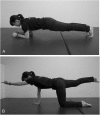A Prospective, Randomized, Controlled Trial Comparing Conservative Treatment With Trunk Stabilization Exercise to Standard Hip Muscle Exercise for Treating Femoroacetabular Impingement: A Pilot Study
- PMID: 31241527
- PMCID: PMC6613832
- DOI: 10.1097/JSM.0000000000000516
A Prospective, Randomized, Controlled Trial Comparing Conservative Treatment With Trunk Stabilization Exercise to Standard Hip Muscle Exercise for Treating Femoroacetabular Impingement: A Pilot Study
Abstract
Objective: To assess the efficacy of conservative management of women with femoroacetabular impingement (FAI) using trunk stabilization.
Design: Randomized controlled trial (level of evidence: I).
Subjects: Twenty FAI female patients who met the inclusion FAI criteria.
Methods: A prospective, randomized, controlled study was performed on 20 female patients with symptomatic FAI comprising 2 groups (10 hips in trunk stabilization exercise group vs 10 hips in control group). We evaluated hip range of motion, isometric muscle strength using a handheld dynamometer (μ-TasMF-01; Anima, Co), and patient-reported outcome measures, including modified Harris hip score, Vail hip score, and international hip outcome tool 12 (iHOT12) before and at 4 weeks and 8 weeks after the intervention.
Results: There was a significant improvement in the range of motion of hip flexion in the trunk training group detected as early as 4 weeks after the intervention compared with the control group (P < 0.05). Hip abductor strength significantly improved in the trunk training group at 4 weeks after the intervention, whereas it did not improve in the control group (P < 0.05). Vail hip score and iHOT12 were significantly increased at 8 weeks after the intervention in the trunk training group compared with the control group (iHOT12: 78.7 ± 22.4 vs 53.0 ± 22.3; P < 0.01, Vail hip score: 81.6 ± 18.5 vs 61.1 ± 11.6; P < 0.05). There was no significant difference in the modified Harris hip score between both the groups at 4 and 8 weeks after the intervention.
Conclusions: The addition of trunk stabilization exercise to a typical hip rehabilitation protocol improves short-term clinical outcomes and may augment nonoperative and postoperative rehabilitation.
Conflict of interest statement
S. Uchida is a consultant for Smith & Nephew and Zimmer-Biomet and receives research funds from Smith & Nephew and Stryker. D. K. Matsuda is a consultant for Zimmer-Biomet. The remaining authors report no conflicts of interest.
Figures





References
-
- Ganz R, Parvizi J, Beck M, et al. Femoroacetabular impingement: a cause for osteoarthritis of the hip. Clin Orthop Relat Res. 2003;417:112–120. - PubMed
-
- Ito K, Minka MA, II, Leunig M, et al. Femoroacetabular impingement and the cam-effect. A MRI-based quantitative anatomical study of the femoral head-neck offset. J Bone Joint Surg Br. 2001;83:171–176. - PubMed
-
- Philippon MJ, Briggs KK, Yen YM, et al. Outcomes following hip arthroscopy for femoroacetabular impingement with associated chondrolabral dysfunction: minimum two-year follow-up. J Bone Joint Surg Br. 2009;91:16–23. - PubMed
-
- Agricola R, Bessems JH, Ginai AZ, et al. The development of cam-type deformity in adolescent and young male soccer players. Am J Sports Med. 2012;40:1099–1106. - PubMed
-
- Ilizaliturri VM, Jr, Nossa-Barrera JM, Acosta-Rodriguez E, et al. Arthroscopic treatment of femoroacetabular impingement secondary to paediatric hip disorders. J Bone Joint Surg Br. 2007;89:1025–1030. - PubMed
Publication types
MeSH terms
LinkOut - more resources
Full Text Sources
Research Materials
Miscellaneous

